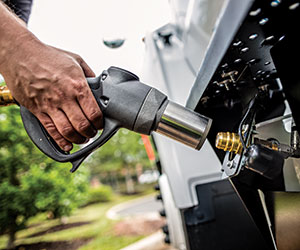Propane Fuel Basics

Also known as liquefied petroleum gas (LPG) or propane autogas, propane is an alternative fuel that's been used for decades to power light-, medium-, and heavy-duty propane vehicles.
Propane is a three-carbon alkane gas (C3H8). It is stored under pressure inside a tank as a colorless, odorless liquid. As pressure is released, the liquid propane vaporizes and turns into gas that is used in combustion. An odorant, ethyl mercaptan, is added for leak detection. (See fuel properties.)
Propane has a high octane rating, making it an excellent choice for spark-ignited internal combustion engines. If spilled or released from a vehicle, it presents no threat to soil, surface water, or groundwater. Propane is produced as a byproduct of natural gas processing and crude oil refining. It accounts for about 2% of the energy used in the United States. Of that, less than 3% is used for transportation. Its main uses include home and water heating, cooking and refrigerating food, clothes drying, and powering farm and industrial equipment. The chemical industry also uses propane as a raw material for making plastics and other compounds.
Propane as an Alternative Fuel
Interest in propane as an alternative transportation fuel stems from its domestic availability, high-energy density, and relatively low cost. It is the world's third most common transportation fuel, behind gasoline and diesel, and is considered an alternative fuel under the Energy Policy Act of 1992.
Propane used in vehicles is specified as HD-5 propane and is a mixture of propane with smaller amounts of other gases. According to the Gas Processors Association's HD-5 specification for propane, it must consist of at least 90% propane, no more than 5% propylene, and 5% other gases, primarily butane and butylene. (See fuel properties.)
For vehicle fueling, the quick-release "Type K15" dispenser connector is required to be installed on all new vehicles as of January 1, 2020, per National Fire Protection Association Code 58. This connector allows for one-handed fueling and does not require the use of personal protective equipment such as gloves and face shield (which are required for the older style connector).
Propane is stored onboard a vehicle in a tank pressurized to about 150 pounds per square inch—about twice the pressure of an inflated truck tire. Under this pressure, propane becomes a liquid with an energy density 270 times greater than its gaseous form. Propane has a higher octane rating than gasoline, so it can be used with higher engine compression ratios and is more resistant to engine knocking. However, it has a lower British thermal unit rating than gasoline, so it takes more fuel by volume to drive the same distance.
To find the fuel, see propane fueling station locations. For retail fuel prices, see the Alternative Fuel Price Report.